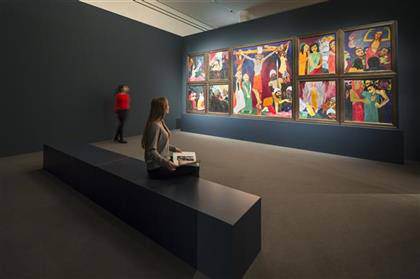
Sword, late 8th–early 9th century.
Kalundborg or Holbæk, Zealand, Denmark.
Photo: John Lee. © The National Museum of Denmark.
Background: Kim Westerskov/Getty Images.
Vikings: life and legend, an exhibition at the British Museum
Vikings conquer the British Museum The British Museum presents its first major exhibition on Vikings in over 30 years, supported by BP, from 6 March to 22 June 2014.]]>
Source: British Museum
The exhibition features many new archaeological discoveries and objects never seen before in the UK alongside important Viking Age artefacts from the British Museum’s own collection and elsewhere in Britain and Ireland. It capitalises on new research and thousands of recent discoveries by both archaeologists and metal-detectorists, to set the developments of the Viking Age in context. These new finds have changed our understanding of the nature of Viking identity, trade, magic and belief and the role of the warrior in Viking society. Above all, it was the maritime character of Viking society and their extraordinary shipbuilding skills that were key to their achievements. At the centre of the exhibition are the surviving timbers of a 37-metre-long Viking warship, the longest ever found and never seen before in the UK. Due to its scale and fragility it would not have been possible to display this ship at the British Museum without the new facilities of the Sainsbury Exhibitions Gallery.
The Vale of York Hoard is displayed in its entirety at the British Museum for the first time since it was discovered by metal detectorists near Harrogate in 2007 and jointly acquired by the British Museum and York Museums Trust. Consisting of 617 coins, 6 arm rings and a quantity of bullion and hack-silver the Vale of York Hoard is the largest and most important Viking hoard since the Cuerdale Hoard was found in Lancashire in 1840, part of which is also included in the exhibition.
Ostentatious jewellery of gold and silver demonstrates how status was vividly displayed by Viking men and women. These include a stunning silver hoard from Gnezdovo in Russia, never previously seen in the UK, which highlights the combination of Scandinavian, Slavic and Middle Eastern influences which contributed to the development of the early Russian state in the Viking Age.
Neil MacGregor, Director of the British Museum said “The reach and cultural connections of the Viking Age make it a remarkable story shared by many countries, not least here in the British Isles. New discoveries and research have led to a wealth of new information about the Vikings so it is a perfect moment to look again at this critical era.”
Related content
Life and death, Pompeii & Herculaneum- British Museum (exhibition, 2013)
Follow us on:


